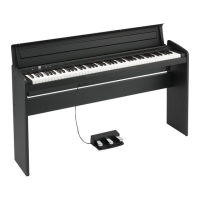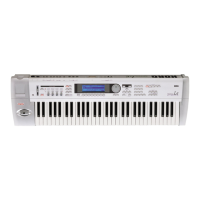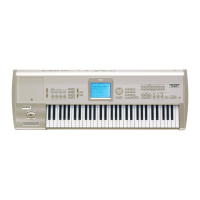Global P0: Basic Setup 0–2: System Preference
359
be received. Use Set Prog User-Bank Type to change
the bank type before you receive a data dump.
System Clock [Internal, S/P DIF]
This sets the system clock, or word clock, of the M3.
When connecting multiple digital audio devices–such as the
M3, a S/P DIF device–it is important that the word clocks of
the devices be locked together. If the clocks are not locked,
the audio may be marred by pops and clicks.
The M3 can lock to incoming clocks from any of its digital
inputs, or it can generate its own clock.
Internal: The M3 will use its own internal clock. This is the
default setting.
S/P DIF: The M3 will use the S/P DIF IN as the master clock.
48 kHz word clocks is supported, according to the S/P DIF
Sample Rate setting.
If System Clock is set to S/P DIF, but the M3 is not
detecting a valid clock signal, you’ll see the message
“Clock Error!” at the top of the display. More
importantly, the M3 will not sound correctly.
If this occurs, check the following:
• Make sure that the word clock settings of all connected
devices are set up correctly, and that there is one and
only one device configured to be the word clock master.
• Make sure that the device providing the master clock is
powered on.
• Make sure that all cables are undamaged, and are
connected properly. If possible, try using different
cables.
Note: The System Clock setting can be stored by the Write
Global Setting menu command.
Note: The System Clock setting is ignored if you are using
the EXB-FW option to transmit or receive digital audio.
The data transmitted by the M3 will automatically be
adjusted to synchronize with the system clock of the
computer to which the M3 is connected. The data received
by the M3 or the computer will automatically be adjusted to
synchronize with the M3’s system clock.
Power On Mode [Reset, Memorize]
Specifies the condition at power-on.
Reset: The M3 will be in Combination mode P0: Play, and
Combination INT–A000 will be selected.
Memorize: The location (mode and page) in which you
were when you last powered-off the M3 will be recalled. If
you were in Program or Combination mode, the program or
combination bank/number at power-off will be recalled.
This function does not memorize the contents of any
parameters that were edited. Before turning off the
power, be sure to write your data or save it in Media
mode.
Beep Enable [Off, On]
On (checked): A beep will be heard when you press an
object in the display.
Auto Optimize RAM [Off, On]
If RAM is specified as the data writing destination for
sampling, this parameter specifies whether the sample
memory (RAM) will be optimized after data is written.
Optimization rearranges any unused memory areas so that
all of the remaining memory can be used.
On (checked): RAM will automatically be optimized when
sampling ends.
With this setting, you will always be able to sample without
wasting RAM, but the sound will stop when sampling ends.
If a song was playing in Sequencer mode, the playback will
stop.
Off (unchecked): RAM will not be optimized when
sampling ends. Since the sound will not stop when
sampling ends, this setting is convenient when you want to
consecutively sample several sections while a song plays or
while listening to an input source such as a CD.
If Auto Optimize RAM is turned Off (unchecked) and
unused areas have accumulated in memory, you can use the
menu command Optimize RAM to perform the same
function manually. For more information, please see
“Optimize RAM” on page 107.
The remaining amount of sample memory (RAM) can be
checked in Sampling mode. For more information, please
see “0–4a: Free Sample Memory” on page 308.
0–2b: Memory Protect
Program [Off, On]
This setting protects the internal program memory.
On (checked): Internal program memory will be protected,
and the following write operations cannot be performed.
• Writing a program
• Loading program data from media
• Receiving program data via MIDI data dump
Off (unchecked): Data can be written to internal program
memory.
Combination [Off, On]
This setting protects the internal combination memory.
On (checked): Internal combination memory will be
protected, and the following write operations cannot be
performed.
• Writing a combination
• Loading combination data from media
• Receiving combination data via MIDI data dump
Off (unchecked): Data can be written to internal
combination memory.
Song [Off, On]
This setting protects the internal song memory.
However, when the power is turned off, the song data in
song memory will be lost regardless of this setting.
On (checked): Internal song memory will be protected, and
the following write operations cannot be performed.
• Recording to the sequencer
• Loading song data from media
• Receiving song data via MIDI data dump
Off (unchecked): Data can be written to internal song
memory.
Drum Kit [Off, On]
This setting protects the internal drum kit memory.
On (checked): Internal drum kit memory will be protected,
and the following write operations cannot be performed.
• Writing a drum kit
• Loading drum kit data from media
• Receiving drum kit data via MIDI data dump
Off (unchecked): Data can be written to internal drum kit
memory.

